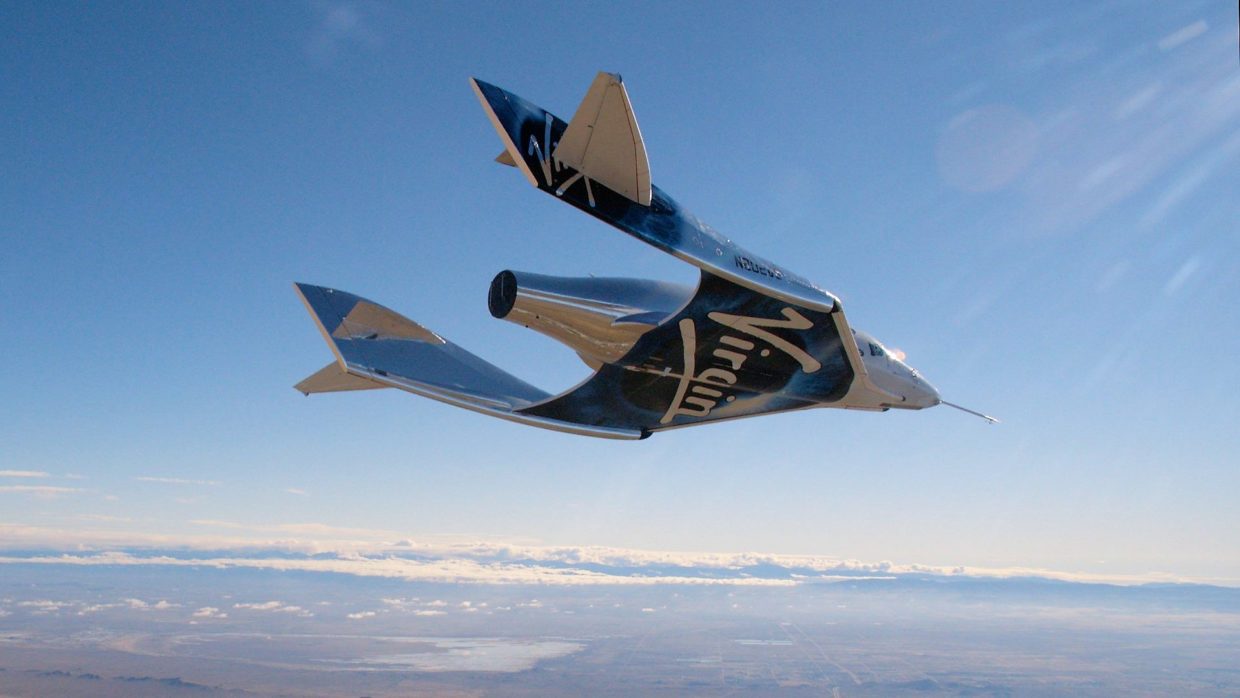
Scenic suborbital views coming soon to the wealthy near you
Virgin Galactic’s original SpaceShipTwo rocket plane. (Virgin Galactic photo)
Commercial spaceflight may get off the ground with paying passengers as soon as next year.
So hopes George T. Whitesides, CEO and president of Virgin Galactic, who shared the company’s plans with a roomful of science journalists during a sleek, high-energy talk during the New Horizons in Science portion of the ScienceWriters2013 meeting Sunday, November 3 in Gainesville, Fla.
Who wouldn’t go?
Early in the event, Whitesides polled the audience, asking if money and safety weren’t factors, who there would want to go to space? Almost everyone raised a hand.
But right now, money is a factor — a big one. Although more than 600 people — “citizen explorers”, including Whitesides and his wife, have put down a deposit for their own suborbital space adventure, a ticket for one of the six seats on SpaceShip Two now runs $250,000. It was originally $200,000, but Virgin Galactic cites inflation for the increase in May 2013. Whitesides will have to wait his turn. Virgin Galactic’s owner and founder, flamboyant British businessman and adventurer Richard Branson, plans to be aboard the first flight with his family.

Why so much? Safety precautions, for one thing. A major problem is America’s recent cultural aversion to risky, “audacious” projects, especially technical ones and especially those involving people. Whitesides called these projects the pathway to progress, but said the fear following accidents and media coverage of those accidents can leave them dead in the water.
No one wants another Challenger or Columbia tragedy happening for anyone, let alone civilians. For commercial spacecraft, he said, an accident rate of even 2 percent — roughly the shuttle program’s figure — is too high.
During the question-and-answer session, Scott Lewis of knowthecosmos.com and Universe Today’s publisher Fraser Cain joined the discussion via Google Hangout. People watching online asked if there would be a payment system similar to a mortgage available for people who wanted to go to space but didn’t have a couple hundred thousand dollars to burn.
From takeoff to landing, the trip will last somewhere roughly two hours, with just under five minutes of it in space. For a $250,000 ticket, rounding to five minutes, that time in space will cost $833.34 per second.
‘Amusement park rides in space’?
Lee Siegel, a science writer for the University of Utah, brought up the scientific return of the venture. Siegel leaned into the microphone to ask pointedly: “Why are we creating amusement park rides in space for rich people?”
Whitesides said that while people have the right to be concerned about how their tax dollars are spent, Virgin Galactic is privately funded. Siegel, he responded, has no reason to tell people how to spend their own money. And at the end of the day, he said, he is personally inspired by sending people to space.
Earlier in the hour, he referenced the overview effect, the “profound impact” of spaceflight on many astronauts. The term comes from a book of the same named written by Harvard scholar Frank White.
Only 542 people have been to space since the first manned space flight in 1961.
The company, Whitesides also said, does have a science-oriented job for its equipment. It plans to invite scientists to send research up in specialized payload racks in place of seats.
Other eventual goals include being able to place research projects in the fuselages, lowering costs so more people can fly, and having two carrier aircraft and five space ships docked at one time in the “Gateway to Space,” the New Mexico spaceport formerly known as Spaceport America.
At one point during his presentation, Whitesides talked the room through a sample trip, from an early morning “right stuff moment” where passengers walk to the spacecraft and can imagine their own movie soundtrack, through rockets and weightlessness, culminating in a glide back to Earth for a party that evening.
Chuck Yeager would feel right at home.